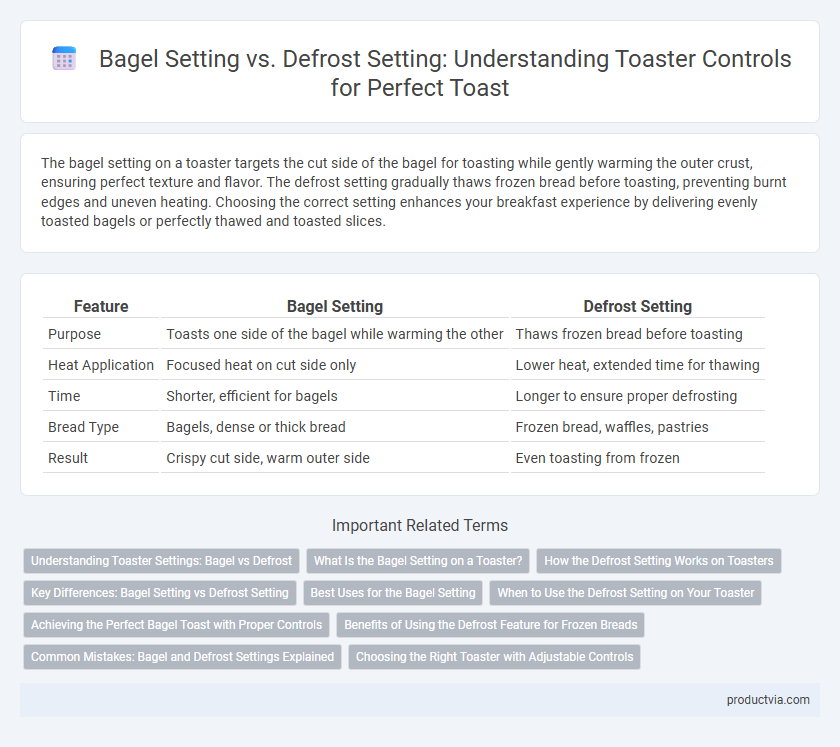The bagel setting on a toaster targets the cut side of the bagel for toasting while gently warming the outer crust, ensuring perfect texture and flavor. The defrost setting gradually thaws frozen bread before toasting, preventing burnt edges and uneven heating. Choosing the correct setting enhances your breakfast experience by delivering evenly toasted bagels or perfectly thawed and toasted slices.
Table of Comparison
| Feature | Bagel Setting | Defrost Setting |
|---|---|---|
| Purpose | Toasts one side of the bagel while warming the other | Thaws frozen bread before toasting |
| Heat Application | Focused heat on cut side only | Lower heat, extended time for thawing |
| Time | Shorter, efficient for bagels | Longer to ensure proper defrosting |
| Bread Type | Bagels, dense or thick bread | Frozen bread, waffles, pastries |
| Result | Crispy cut side, warm outer side | Even toasting from frozen |
Understanding Toaster Settings: Bagel vs Defrost
The bagel setting on a toaster is designed to toast only the cut side of the bagel while gently warming the rounded side, ensuring the perfect balance of crispness and softness. The defrost setting, on the other hand, gently thaws frozen bread or bagels before toasting, preventing uneven heating and sogginess. Understanding these distinct functions helps optimize toasting results based on the specific type of bread and its condition.
What Is the Bagel Setting on a Toaster?
The bagel setting on a toaster is designed to toast only the cut side of a bagel while gently warming the outer crust, ensuring an ideal balance between crispiness and softness. Unlike the defrost setting, which gently thaws frozen bread before toasting, the bagel function specifically enhances the texture and flavor of bagels by applying direct heat to the inside surface. This control optimizes toasting performance for bagels, preserving their chewy interior and golden exterior.
How the Defrost Setting Works on Toasters
The defrost setting on toasters is designed to gently thaw frozen bread or bagels before toasting, using a lower heat and longer cooking time to ensure even warming without burning. This function prevents the exterior from burning while the inside remains frozen by gradually bringing the bread to room temperature. Using the defrost setting maintains texture and flavor, especially important for frozen bagels that require thorough heating through dense interiors.
Key Differences: Bagel Setting vs Defrost Setting
The Bagel Setting on toasters focuses heat on the cut side to give a crispier texture while gently warming the rounded side, ideal for achieving the perfect toasted bagel. The Defrost Setting extends the toasting time and reduces heat intensity to safely thaw and toast frozen bread without burning. Key differences include heat distribution--uneven for bagels, even for defrost--and time adjustments tailored to the type of bread being toasted for optimal results.
Best Uses for the Bagel Setting
The bagel setting on a toaster is specifically designed to toast only the cut side of bagels while gently warming the outer crust, preserving its chewiness and preventing burning. This setting is ideal for bagels, English muffins, and similar bread with a dense texture that benefits from focused toasting on one side. Using the bagel setting enhances flavor and texture by delivering a perfectly toasted interior and a soft exterior without drying out.
When to Use the Defrost Setting on Your Toaster
The defrost setting on your toaster is designed to thaw frozen bread or bagels before toasting, ensuring even heating without burning the surface. Use this setting when toasting items straight from the freezer to achieve a crispy exterior and fully warmed interior. Selecting defrost helps maintain the texture and flavor of frozen baked goods by gently warming them prior to the toasting cycle.
Achieving the Perfect Bagel Toast with Proper Controls
Bagel setting on a toaster is designed to toast the cut side of the bagel while warming the outer side, using higher heat on the inner surface for a crispy texture. Defrost setting gently thaws frozen bread or bagels before toasting, preventing uneven heating and sogginess by extending toasting time at a lower temperature. Selecting the bagel setting ensures an ideal balance of crispiness and warmth, while the defrost setting is essential when working with frozen bagels to achieve a perfect, evenly toasted result.
Benefits of Using the Defrost Feature for Frozen Breads
The defrost setting on toasters is specifically designed to gently thaw frozen breads before toasting, ensuring even heat distribution and preventing the exterior from burning while the interior remains cold. Using the defrost feature preserves the texture and flavor of frozen bagels, bread slices, and pastries by gradually warming them without causing dryness or toughness. This setting optimizes the toasting process for frozen items, delivering consistent, warm, and crispy results that the standard bagel setting cannot achieve.
Common Mistakes: Bagel and Defrost Settings Explained
Using the bagel setting improperly can result in uneven toasting, as it heats only one side of the bread while keeping the other soft. The defrost setting is designed to thaw frozen bread before toasting, preventing burnt or undercooked toast caused by skipping this step. Confusing these settings leads to either soggy bagels or unevenly toasted frozen bread, affecting the overall quality and texture.
Choosing the Right Toaster with Adjustable Controls
Selecting a toaster with adjustable controls such as a bagel setting and defrost setting enhances versatility and precision. The bagel setting toasts only the cut side for optimal texture, while the defrost setting gently warms frozen bread without burning. Choosing a model that clearly differentiates these functions ensures better results for a variety of bread types.
Bagel Setting vs Defrost Setting for Toaster Controls Infographic

 productvia.com
productvia.com